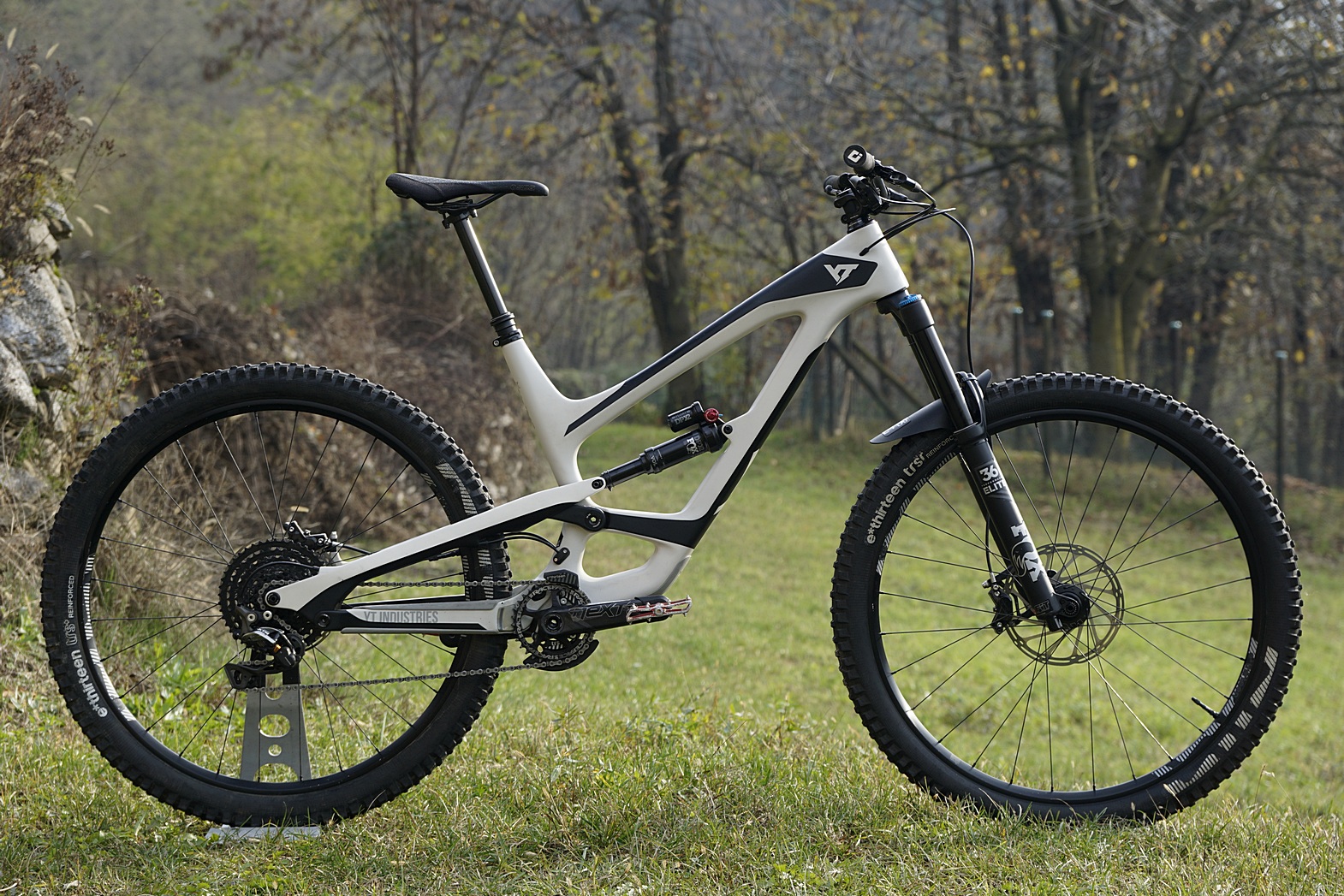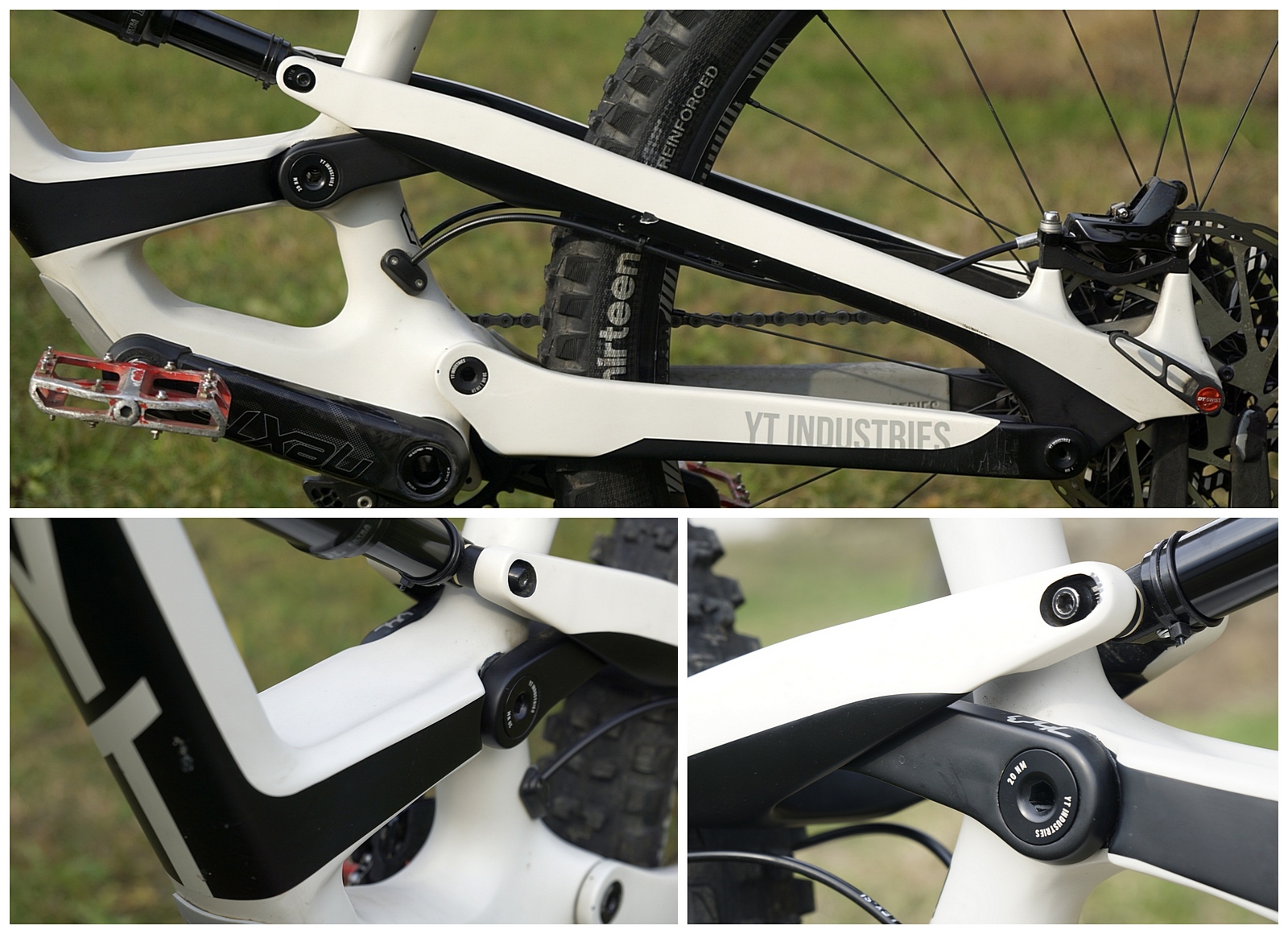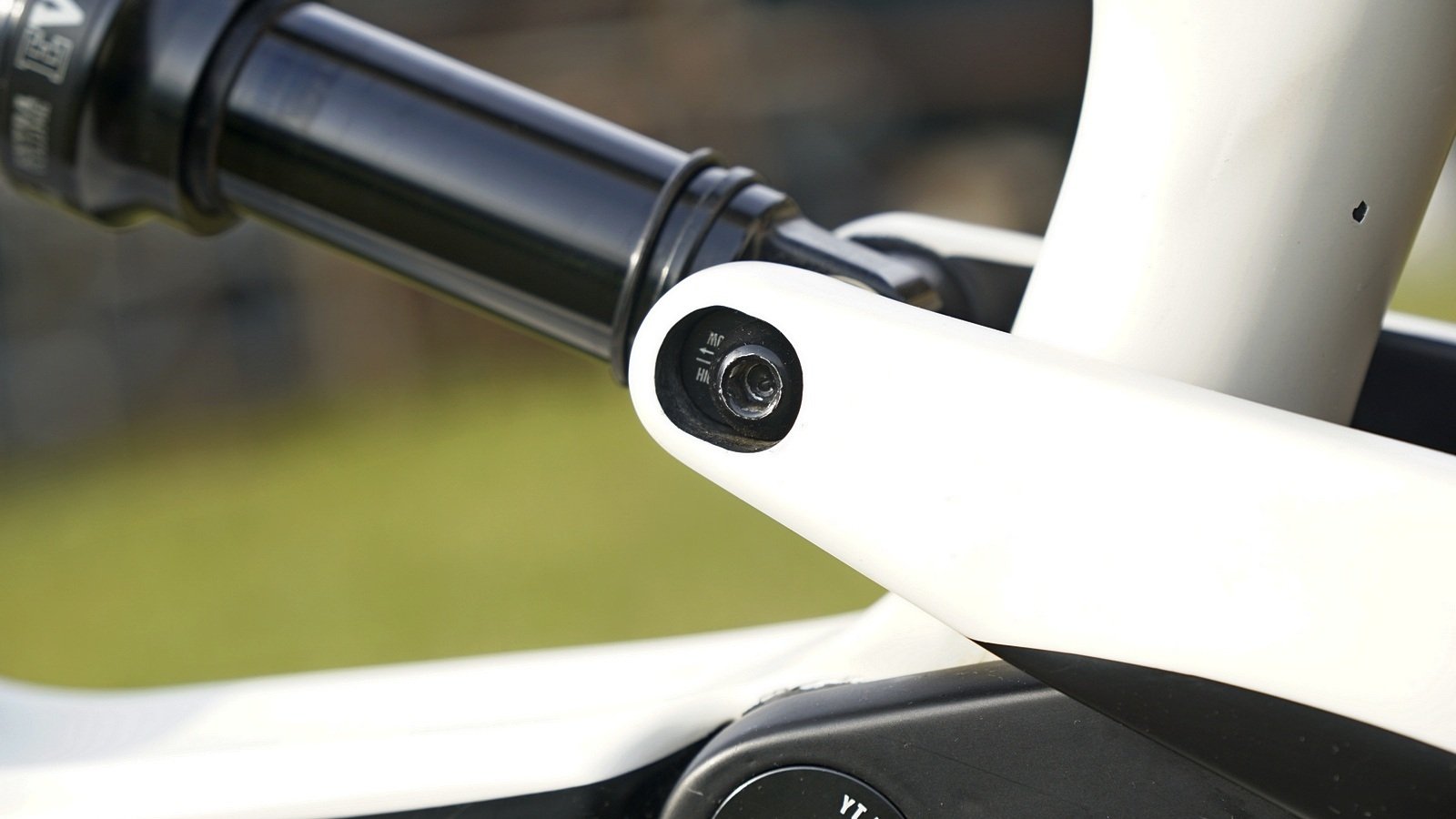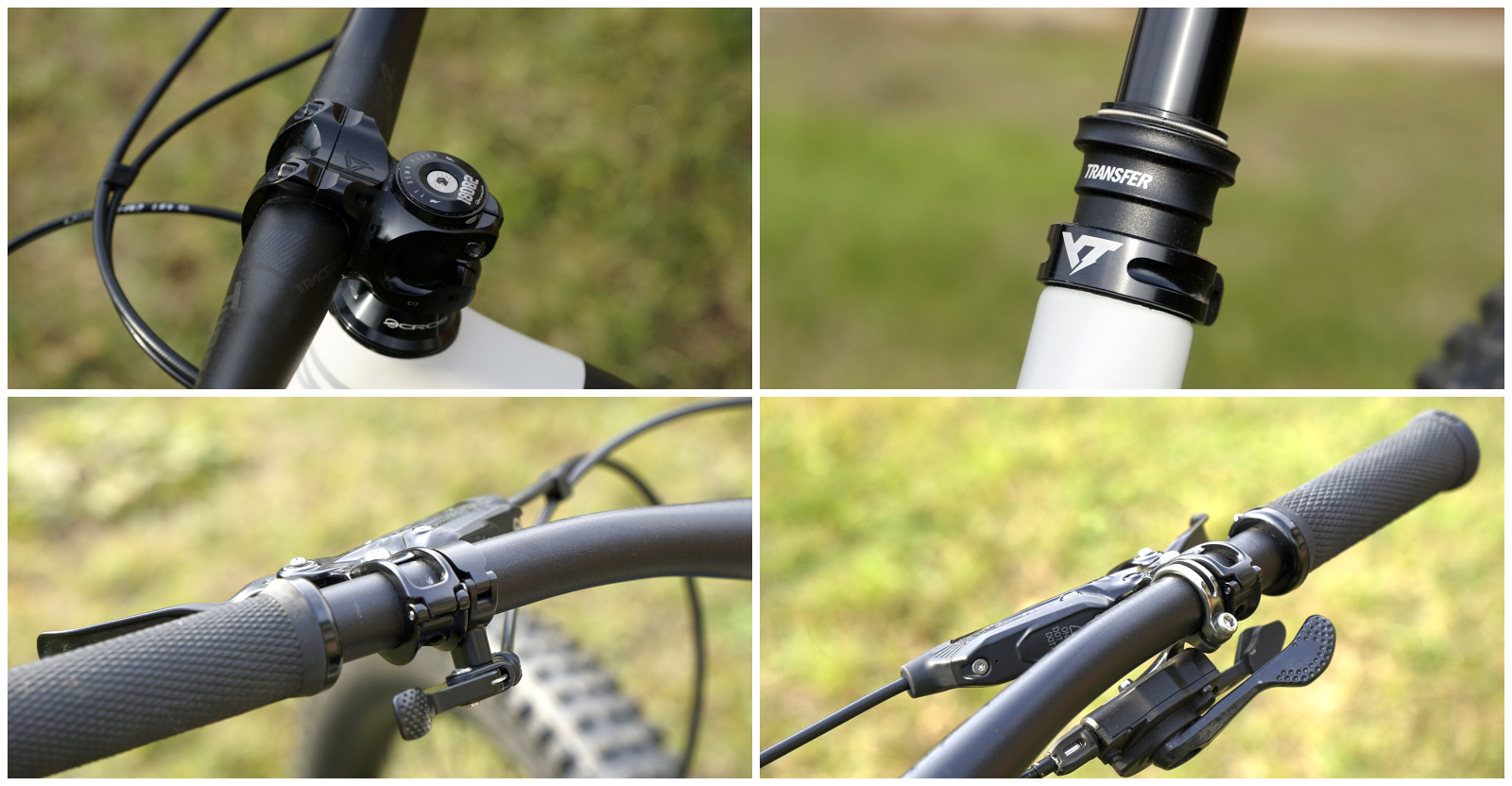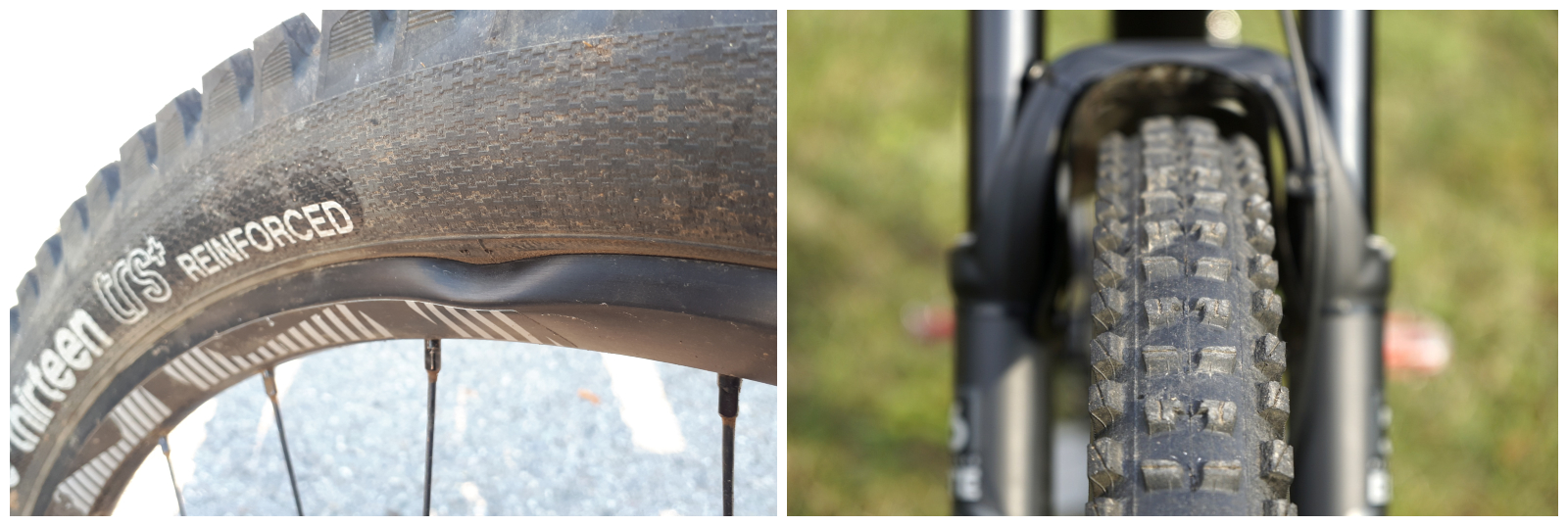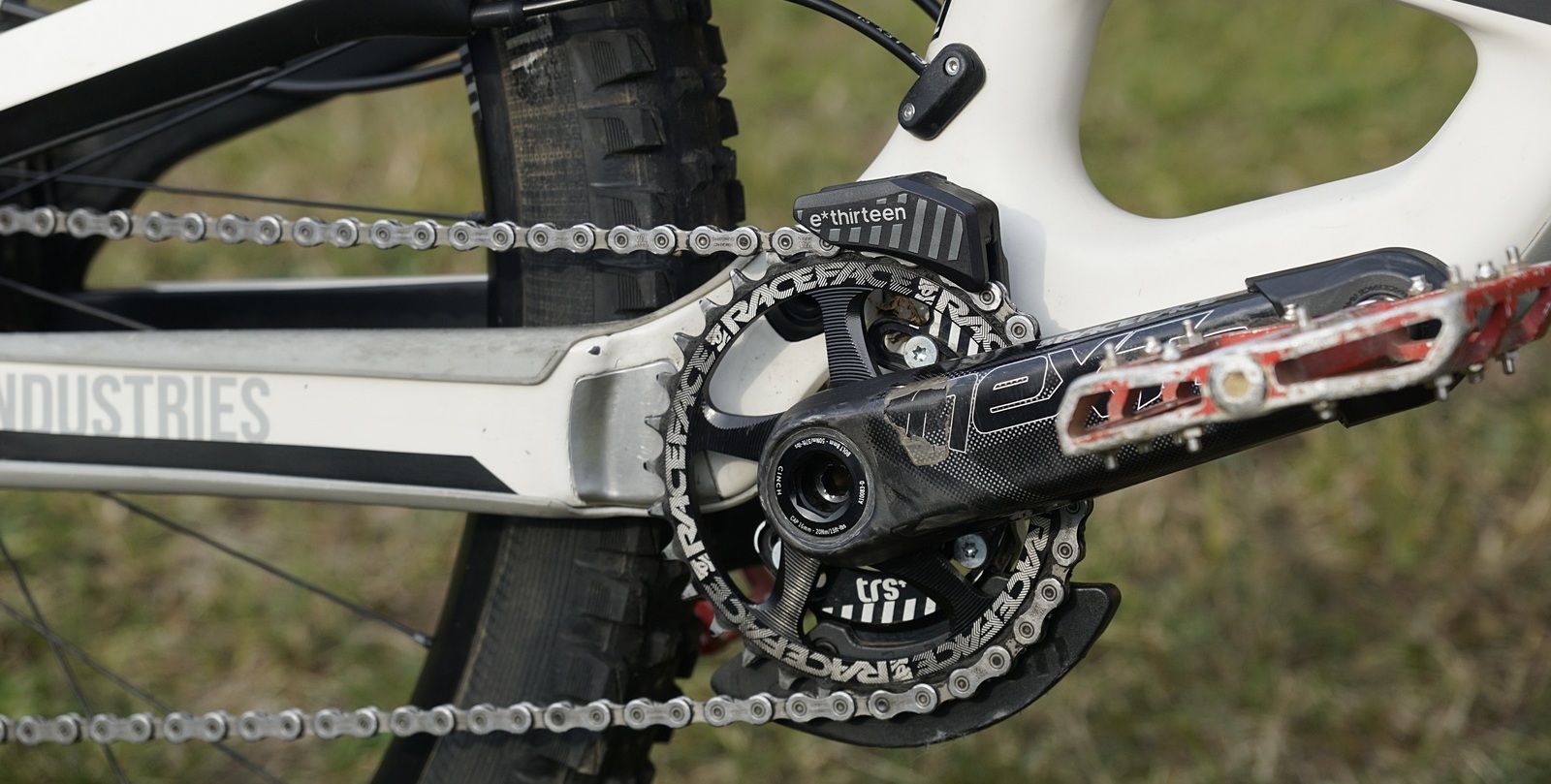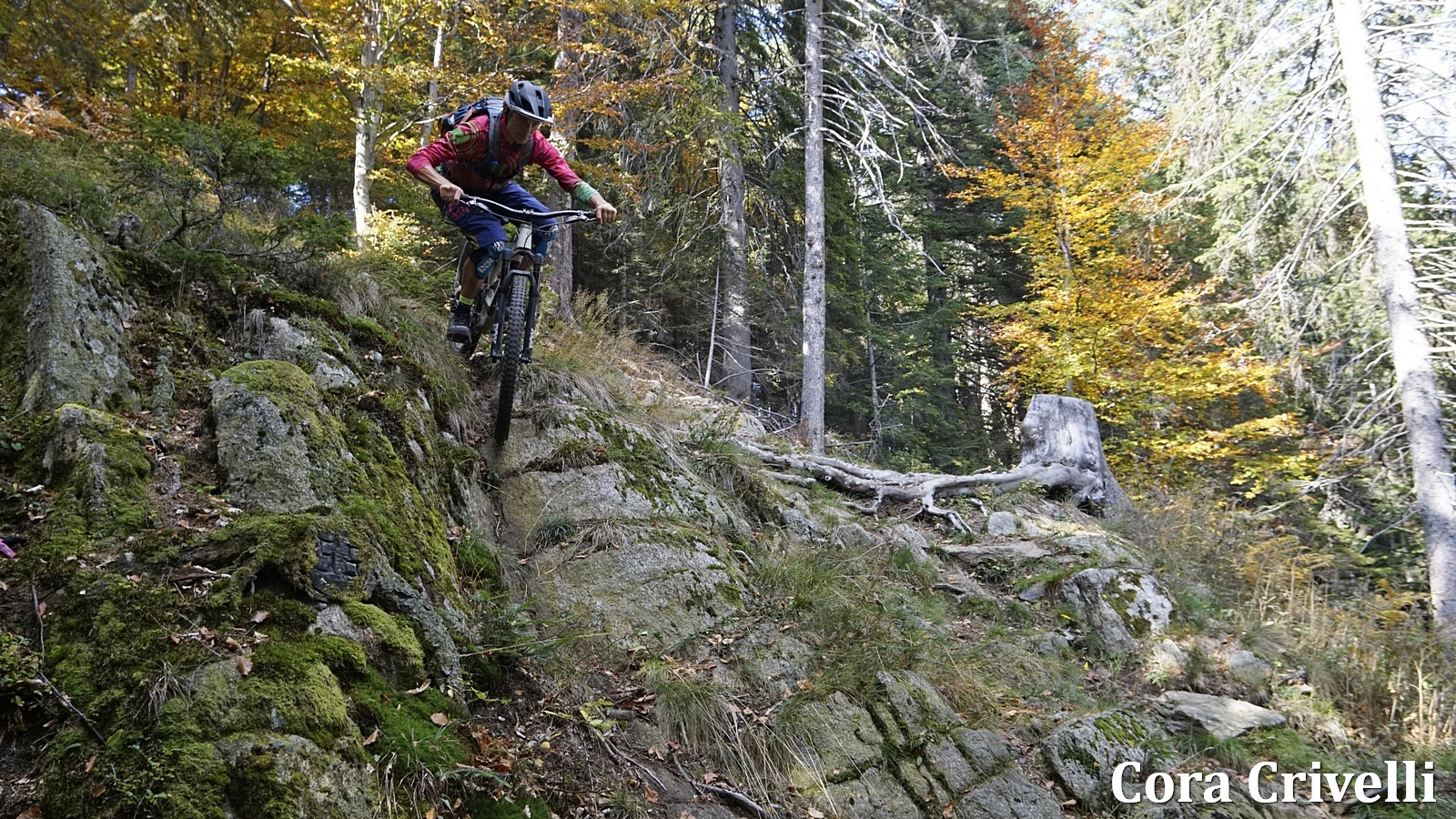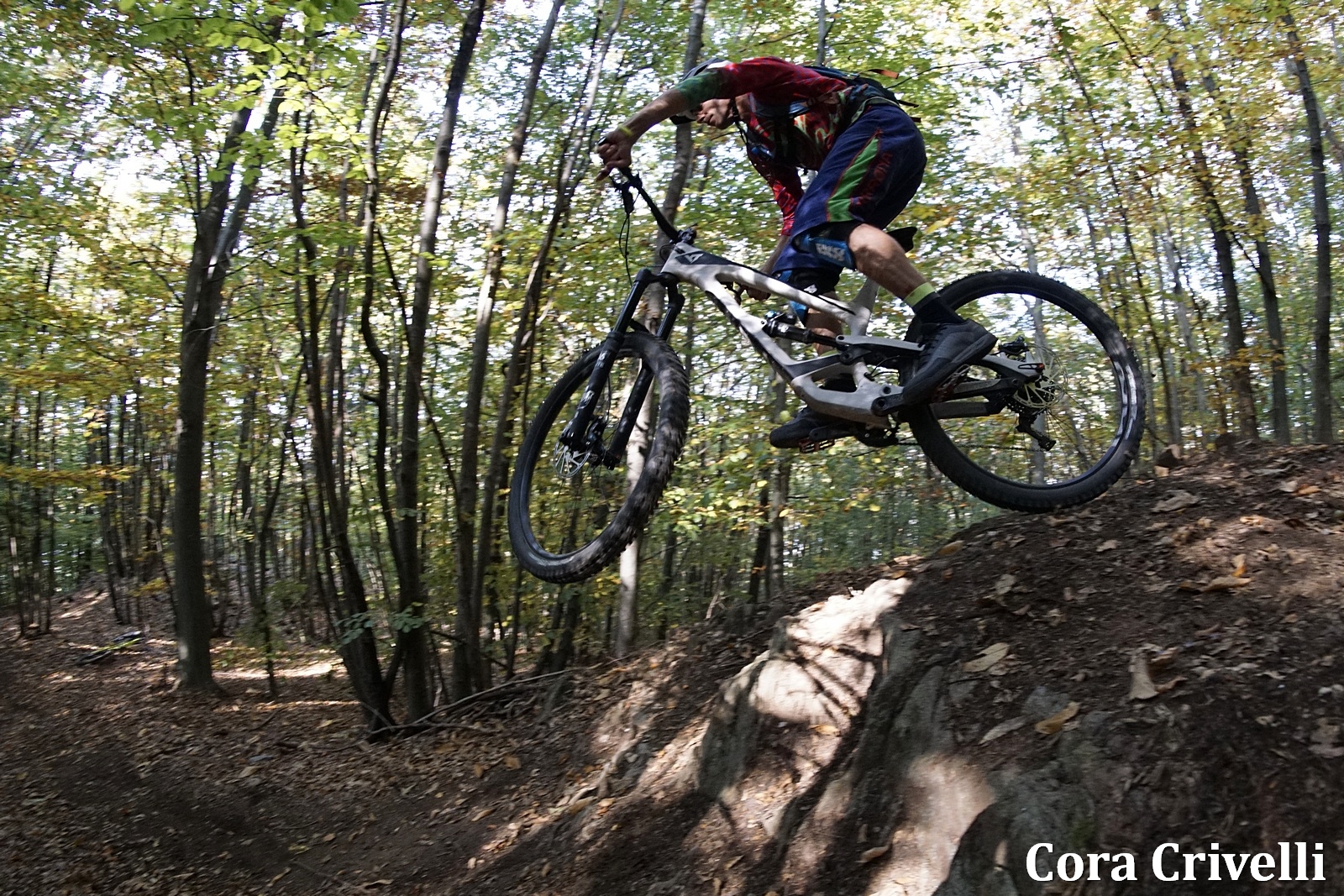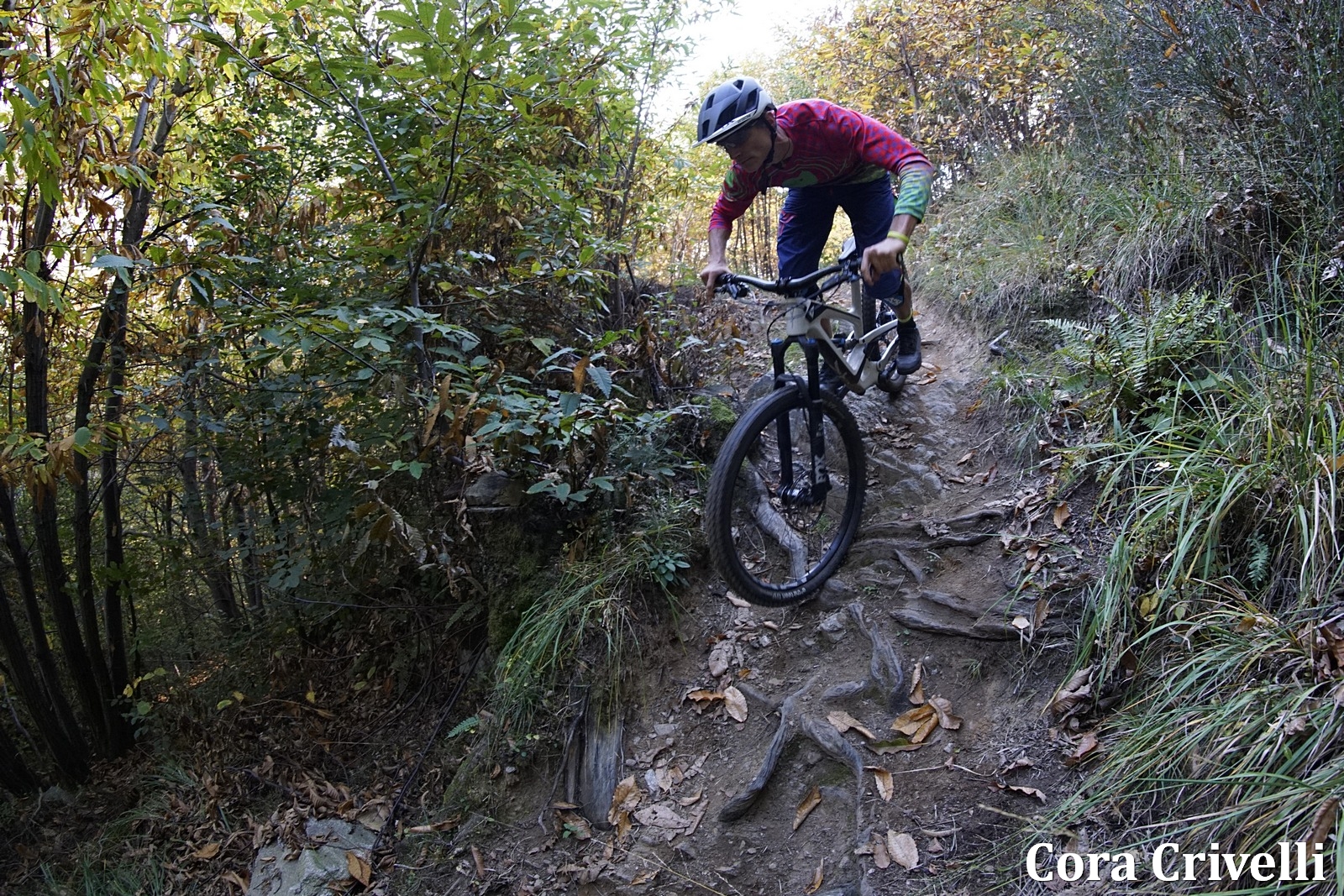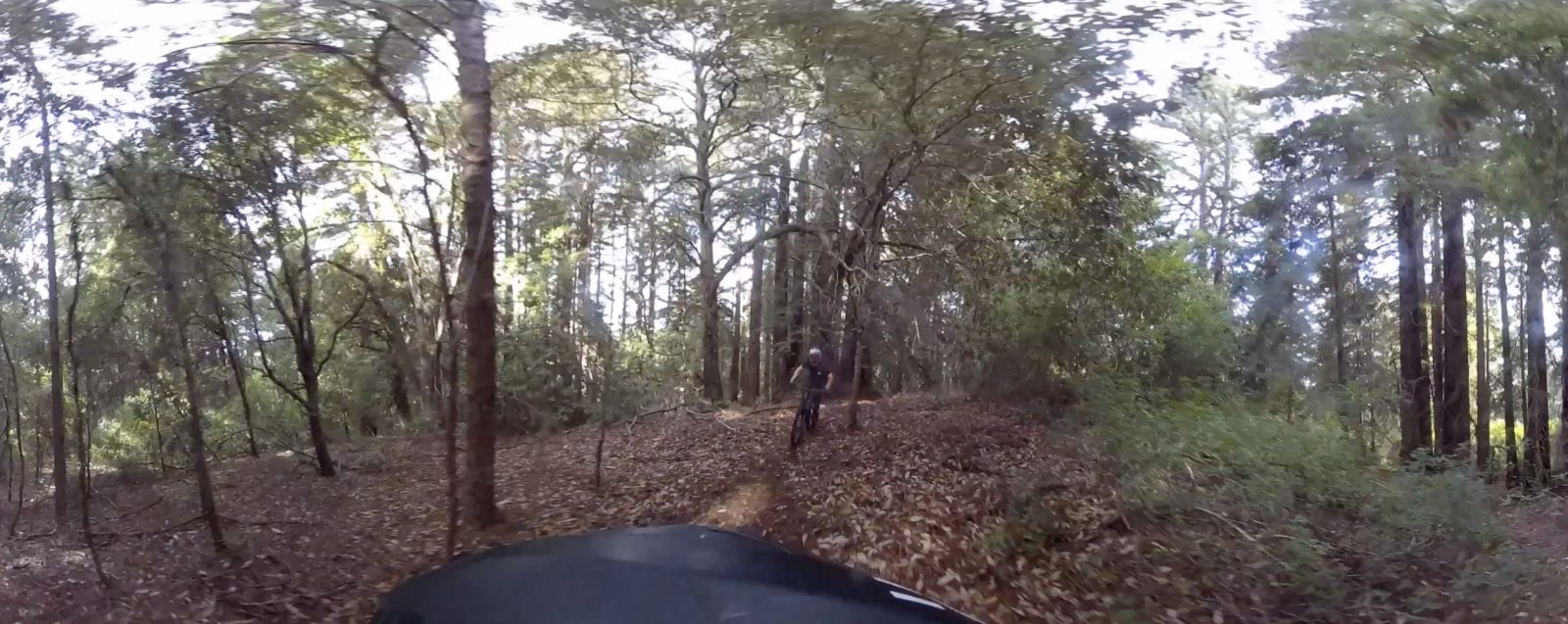In the space of a few years, YT has been able to gain a great popularity not only with very aggressive marketing campaigns, but also well thought out and aesthetically appealing bikes at extremely competitive prices. Opening the gates to this new approach in a certain sense was the Capra, an enduro model initially released in a 27.5″ format and now also available with 29″ wheels.
YT set us up with the larger diameter wheels in the CF Pro spec, the intermediate level one among the three offered with a carbon frame. On the contrary, there are two levels for the aluminum version, which at the chassis level differs only in the material used.
All set-ups include 160 mm travel forks, the same number we find at the rear. The top of the line model is the CF Pro Race, which, although it uses the same frame in the carbon version, has 170 mm travel on both the front and rear and slightly more slack geometry (half degree at the head angle). The increase of travel at the rear wheel is achieved by mounting a rear shock with the same eye to eye but 5mm of additional stroke.
The Capra 29 CF Pro at a glance
- Frame material: Carbon
- Wheel format: 29″
- Sizes available: M / L / XL / XXL
- Suspension scheme: Four bar with Horst coupling
- Adjustable geometry: yes, via flip-chip
- Front / rear stroke: 160/160 mm
- Metric shock absorber: yes (230 × 60 mm)
- Tubeless wheels and tires: yes
- Drivetrain: 1 × 11 with 32T ring / 170 mm cranks
- Front derailleur attachment: no
- ISCG mount: yes
- Bottle holder: no
- Frame only availability: no
- Weight – XL: 14.1 kg
- Price: 4,299 euros
Geometry
I’m used to riding bikes in size L, when requesting the bike for the test I was quite surprised to see that according to YT, at 187 cm tall, I fell in the middle of the range indicated for the size XL.
Beyond the psychological aspect, and although the YT sizing isn’t large, it was still a matter of dealing with a 1252 mm wheelbase combined with 29 “wheels and a 65.5 ° head angle. To increase my perplexity there’s also the fact that the XL and XXL adopt a longer rear end than the M and L, with a chainstay that goes from 435 mm to 440 mm.
Having done this nice preamble we get to the point: after using the Capra for a long time and on the most varied types of trails, I can say that YT’s suggestions are valid, and that going back I would choose the XL size without the slightest delay.
For the most part the Capra adopts modern geometry: slack angles, abundant reach and short seat tubes combined with swooping top tubes to improve the standover.
A “flip chip” device allows you to choose between two different settings with a variation in the angles of about half a degree and of 9 mm of bottom bracket height. Even in the lower/slacker downhill position, the BB has a very acceptable height of 348 mm.
Static analysis
One of the factors that has helped the success of this model since its first appearance, now five years ago, has been a winning aesthetic. Compared to then, refinements were also introduced at the aesthetic level, but the lines remains sleek and modern. It’s always been a bike that’s easy on the eyes. For those who find the color of the bike in test a bit pedestrian, it’s worth noting that the same model is also offered in a more flashy color: “blood red”.
The rear suspension is managed by a four bar layout with a Horst link, and the rear end is quite compact in the vertical direction. In order to prevent flex which a design of this type could easily be subjected to, the structures both front and rear are quite girthy. Both the seatstay and chainstay have a stiffening bridge, in the second case it’s well camouflaged, close to the bottom bracket shell. The perhaps more massive detail, which in a certain sense also characterizes the aesthetics of the bike, is nevertheless the “bridge” connecting the front end at the seat tube and rear end, which drives the shock, at the seatstay.
Despite not leaving room for a bottle, the look and industrial design of the Capra are spot on.
As mentioned, for some time now, YT has been using a Flip Chip device that allows you to set switch between two different geometry settings. This consists of a plate in an offset hole, housed in the seatstays. It can change the position of the rear shock’s lower eyelet by a few millimeters. In other words, it is like being able to change the eye to eye length of the shock, and effectively change the bike’s attitude.
In theory, swapping from one position to another is feasible in the field: the two plates (one on each side) must be removed, rotated by 180 ° and reinserted at the new position.
Limits of a solution of this type are that you have to stop, use two keys and be careful not to lose the plates, but in the past I used the Flip Chip on Jeffsy and didn’t encountered any problems.
In the case of the Capra in test, extracting the pin was instead very difficult, to the point of passing up the already unwanted desire to do so during a ride. The problem was due to a slight crowning of the bolt on the side with the threaded hole. In consideration of past experiences, it is reasonable to believe that this was a fluke, and in any case the problem would have been easily solved with a slight turn on a lathe.
The cable routing is all internal, inside the frame. The fastening plates close to the bottom bracket are effective, while the conical rubbers used at the other entry points – in particular those which are inserted in the head tube area – tend to unseat.
The frame protection is effective and well positioned. The drive side chainstay is also internally protected, just as the seatstay is protected from the slapping of the chain. YT deployed an intelligent solution to prolong the protection of the downtube near the BB, an area that, as the photos show, is rather exposed to errant rocks and stones. There’s also a classic metal plate to protect the chainstay in the case of chain suck.
The suspension is both from Fox’s Float Performance Elite series, units that have little to envy in their big brother “Factory” series.
In the 36 I inserted two volume reducers, which together with a pressure value a little higher than recommended for my weight allowed me to never have to resort to using invasively heavy damping.
The DPX2 is a shock absorber that I like very much, in my opinion, better performing than the SuperDeluxe of RS and at the same time lighter and less problematic to set up as the X2 from Fox. The fine tuning of the compression in open mode is particularly useful, specifically because the effectiveness of the suspension during the pedaling phase can be optimized.
Inside the shock was a 0.2 in³ volume reducer, the smallest available. A rather high air pressure is required by the Capra, in my case (about 75 kg with no gear) over 220 psi is needed for a sag of 35%.
The current geometries have led to the use of stems that until a few years ago would have seemed very short. The same applies to the handlebars, which however keep widening. On the Capra we find two components of the proven Turbine series from Race Face, measuring 40 mm and 800 mm respectively. The 35 mm bar height and rather tall headset Acros determine a height up front that I personally found perfect, but if you wanted to go lower, you’d need a lower bar.
Not adopting components of a single family, on neither side of the bar was it possible to group the various controls on a single collar. Beyond the aesthetic factor and a minor increase in weight, all the levers are still in an optimal position.
Still on the subject of levers, those of the Code RSC brakes have maintained a perfect feeling from the first to the last day of testing, ensuring precise and powerful braking fitting for a gravity-oriented system. The discs are 200 mm in both front and back.
Nothing to complain about at the operating level with regard to the Fox Transfer dropper, which however is not available with more than 150 mm lowering. For an XL size, I’d prefer to see a bit more travel.
As the photo shows, the e* thirteen wheels didn’t exactly shine in terms of strength. That said, I really liked the tires (also from e* thirteen). Although they didn’t roll all that fast, they had very good wear resistance in relation to the softness of the compound. For mainly downhill use it’s hard to ask for much more. If instead you have to endure a great bit of climbing, perhaps on asphalt and in summer conditions, a faster rolling back tire would make sense.
The drivetrain is a potpourri of brands: Race Face 32T crankset, Shimano drivetrain and chain, e* thirteen 9-46T 11 speed cassette. The overall impression was that the mixed bag is a bit noisier than a complete group from Shimano, but had no problem in terms of effectiveness. The chain guide with bash is also part of the TRS + series from e* thirteen, a very useful accessory on the most technical trails.
Climbing
Despite the short stem, with a 642 mm length top tube the pedaling position is sufficiently relaxed. However, some problems can arise for those that tend to run their saddle quite high as the slack seat tube angle leads to a rather rearward positioning. This was my case, and to solve it, at least partially, it was necessary to slide the saddle to the furthest forward position possible. The steeper geometry setting would be helpful, but as mentioned, the test bike’s flip chip had some problems. Furthermore, experience shows that with devices of this kind, I typically end up setting the most downhill friendly set-up and forgetting about it.
Finding an acceptable body position, the Capra proved to be a pretty good climber, which can be even better on asphalt or dirt roads and/or by fitting a smoother, faster rolling rear tire.
The Fox DPX2 has solid lockout in the firm position, getting rid of any excess movement in the rear suspension. The middle “trail” position, on the other hand, allows the suspension to remain very active, so that traction on technical terrain is very good. Also the Capra proved to be very maneuverable on the steeps – partially because the back end wasn’t too short.
As is reasonable to expect, such a bike is not the definitive weapon to tackle the most ragged and brutal climbs, but when it’s possible to keep a regular gait, the technical bits are handled fairly well.
Descending
Let’s go to the field where this bike should shine: downhill. The Capra did not disappoint.
Thanks to the abundant reach and to the short, but not too short rear end, changes in direction and body positioning never trigger unpredictable reactions, which, along with the long wheelbase and the impeccable work of the suspension, make the Capra extremely stable and safe on fast and uneven terrain. Those coming from an “old style” enduro will have to recalibrate their style a bit both in line choice, now much more direct, and in the management of speed.
The fact that this German Enduro was designed to give its best in the most demanding descents translates directly to its compression curve in the rear suspension. It’s sensitive at the beginning of the travel but very progressive and able to manage even the most violent hits without batting an eyelid. This allowed me to use sag of just under 35% without running into frequent bottom outs. You could add a larger spacer for more progression, but I doubt that anyone will feel this need. Removing the spacer, there are no drastic changes in the suspension, but it is still an option to consider if you can’t use the whole travel or if you like a “softer” edge on medium-sized impacts. It’s worth noting that despite being one of the most progressive bikes on the market, this new iteration of Capra is actually less progressive than the last version.
But now comes the cool part, because even in the tight sections the Capra is anything but slow and reveals that it offers more agility than one would expect. Obviously this feature emerges in the most challenging situations like rough terrain and steep sections, and for the umpteenth time we remember that modern enduro style trails require rather aggressive riding, but the fact remains that on well-known trails characterized by slow and tortuous sections, I did not feel the need for a shorter (and theoretically more agile) bike.
Thinking about it I couldn’t find any particular explanation, evidently due to a sum of factors, not least the well-refined geometry of the new enduro 29ers. From this point of view I think the choice to stretch the wheelbase on the bigger sizes is also a winner, something that does not deaden the bike, but instead contributes to maintaining the right balance, and consequently a very well rounded behavior.
Several times I have heard theorizing that slack geometry would be unsuitable on technical trails, but I don’t think that’s necessarily true. The Capra has given me confirmation of that, finding it more agile than less “extreme” bikes only on slow and flat corners. I don’t remember a single technical section, however, among those I could master with other bikes, that with the Capra I couldn’t overcome while I have at least a couple of them in mind that I could send at the first try when it usually takes me at least a couple of times (clearly it can depend on the conditions or form of the day, but certainly the bike was not limiting).
Moving to to the eternal debate of 27.5 “vs 29″, this test confirms that at present the 27.5” maintains some advantages linked to the intrinsic characteristics of the smaller diameter, not so much in the ability to manage brutal sections, but rather in terms of “playfulness” (speed in changes of direction, ease in lifting the wheels from the ground, etc.).
Overall
The Capra 29 CF Pro fully meets the requirements for a modern enduro: great downhill performance, combined with excellent agility, and still not too bad to pedal uphill. As a brand with direct online sales, the quality / price ratio is also hard to beat compared to models that rely on traditional distribution channels.

